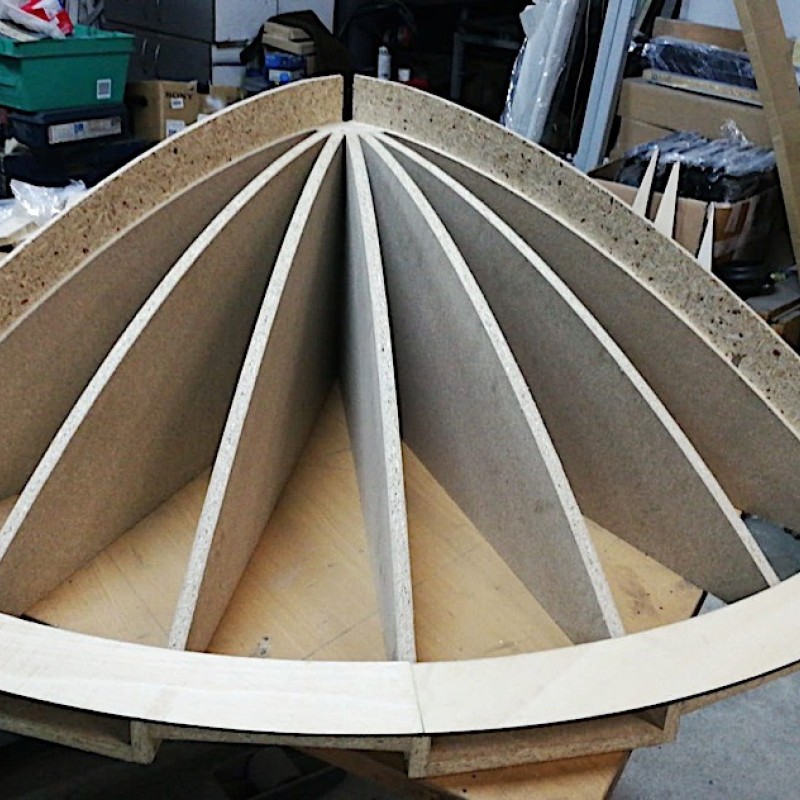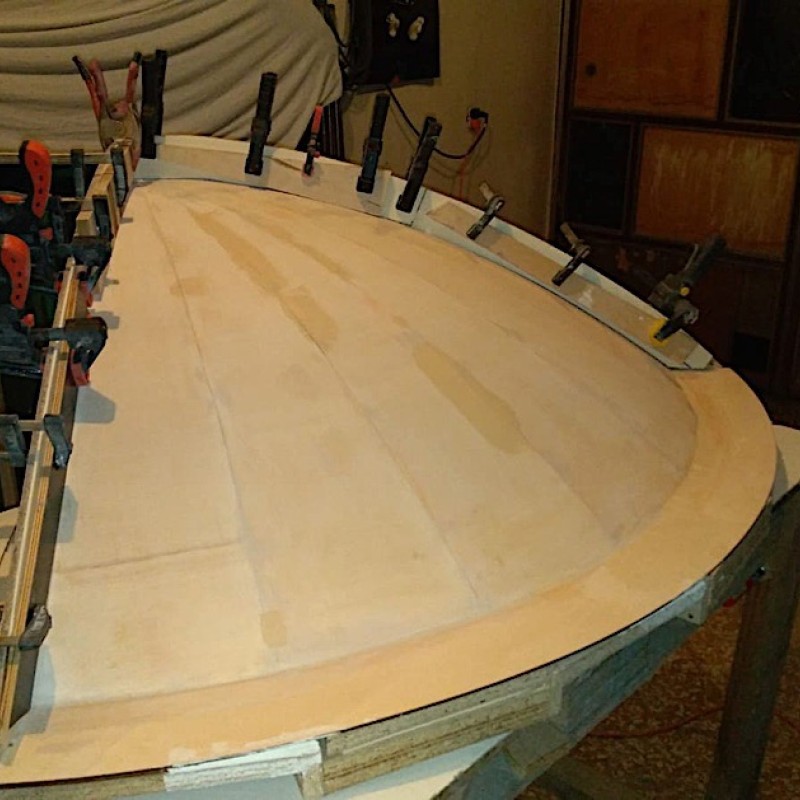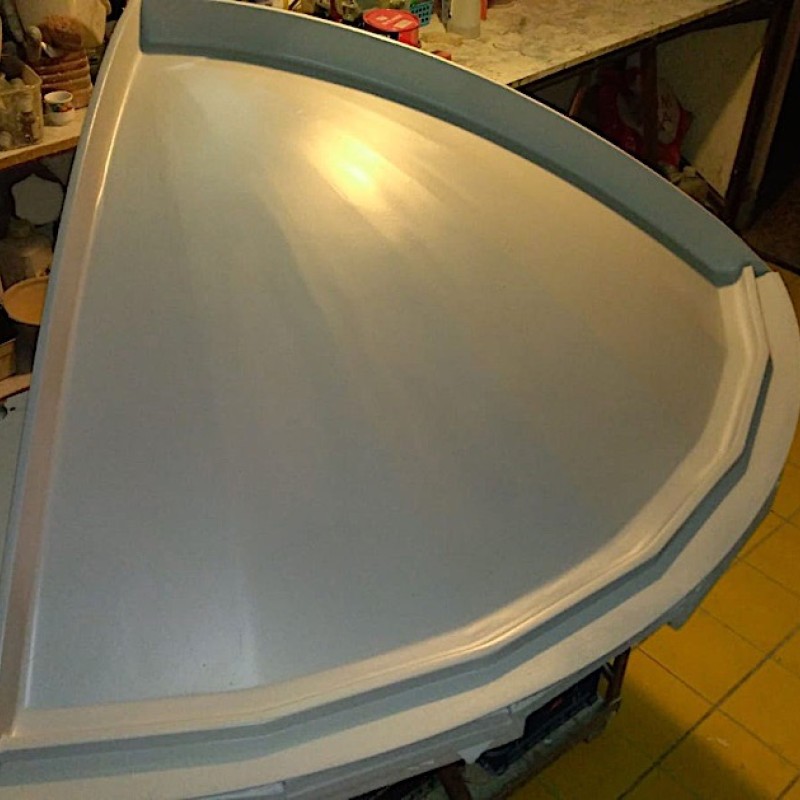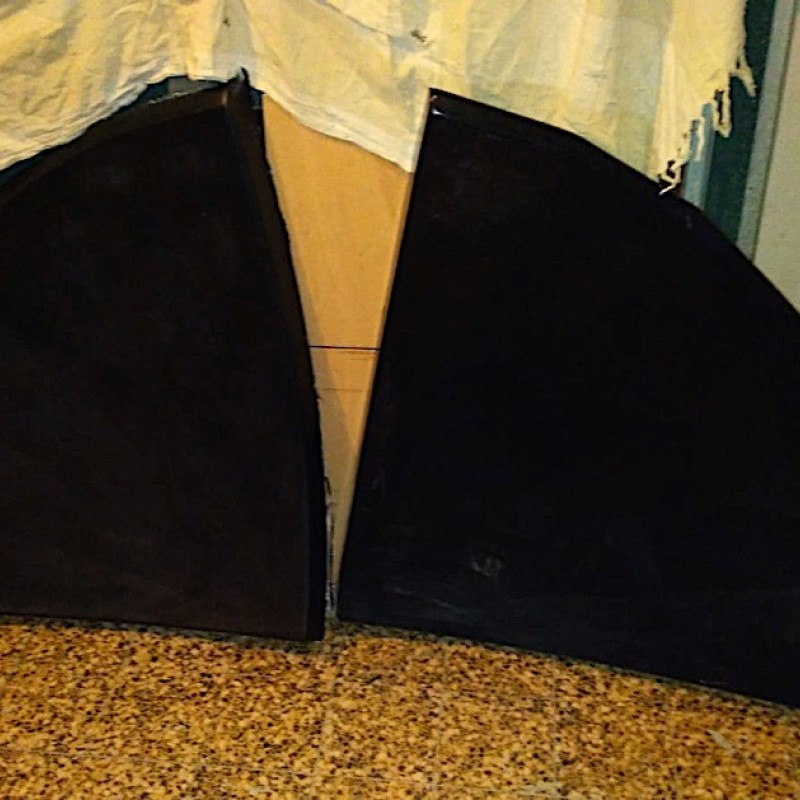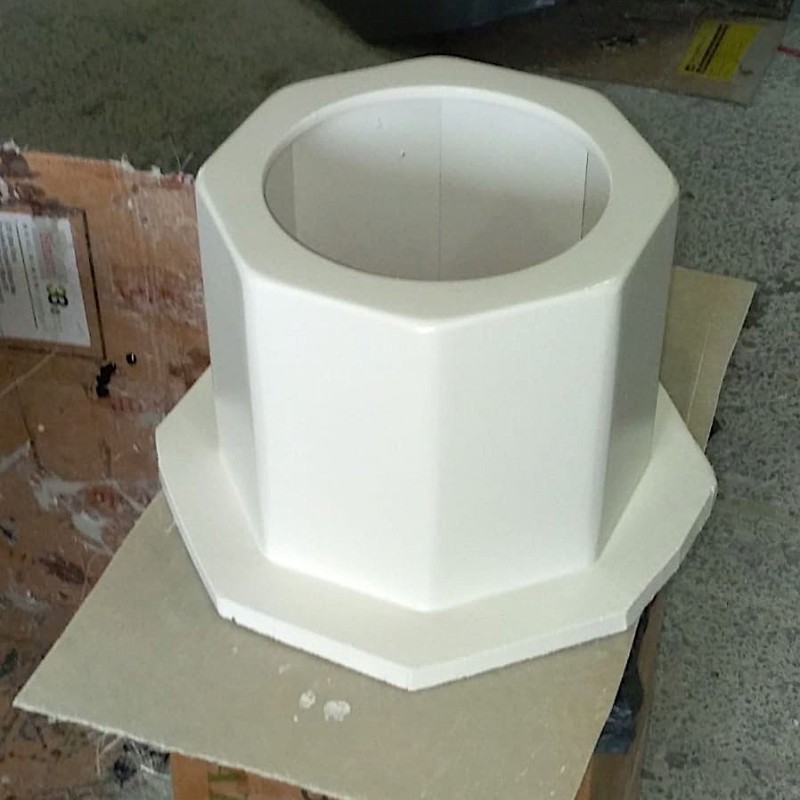Long Throw Speaker

The long throw speaker project will investigate sound as a physical, energetic body within space through amplified cello performance. An exploration of the current technology surrounding long throw sound will be investigated with a means to create a controlled spatial projection of sonic energy.
The research:
This research aims to connect and complete the components of the expanded energetic cello system; the modal system of the cello, its electro acoustic projection through speaker systems and the environment. It details the design of a speaker that explores expanded spatial projection shapes within alternative performance environments. The research is undertaken through an artistic and technical process of researching, field work, design and building and the testing of a number of different long throw speaker designs and environments, culminating in a final art piece.
The cello:
A musical instrument uses its interior energetic vibrational qualities to create sound that is projected into the exterior performance space. Within this space, projected sound will travel and develop before it meets the ears and bodies of the audience. This process is through a complex and highly designed system of vibration of the physical internal and external parts of the instrument. This research will explore the different elements of this sound behaviour, its subsequent projection and phenomena and its direct physical and spatial relationship between performer, instrument, audience and environment.
The speakers:
Up until now there are three different designs of speakers I am looking at; line array, a large parabola and wave field synthesis. Each system has a different approach to harnessing energy; one using a carrier frequency, the other using a parabola to reflect and focus energy and software based to cancel out frequencies to create spatial reflections (research yet to be done).
Research questions:
- How far can sound be projected from a long throw speaker?
- What is the spatial pattern or distribution of sound by the speaker?
- How does the frequency and performance effect the sound projection?
- How does the environment effect the projection of the sound signal: what environmental factors such as wind, trees, walls, room effect the sound reflection, absorption, propagation or expand the signal?
- Can the signal be controlled?
- What are the differences in environments for sound projection, propagation?
- Where is the audience positioned? Do they need to see the performer or the speaker?
- What effects will the lack of proscenium have upon the sound and its subsequent experience?
- Which speakers control sound and cover required frequency bands whilst still maintaining a long throw over a substantial distance?
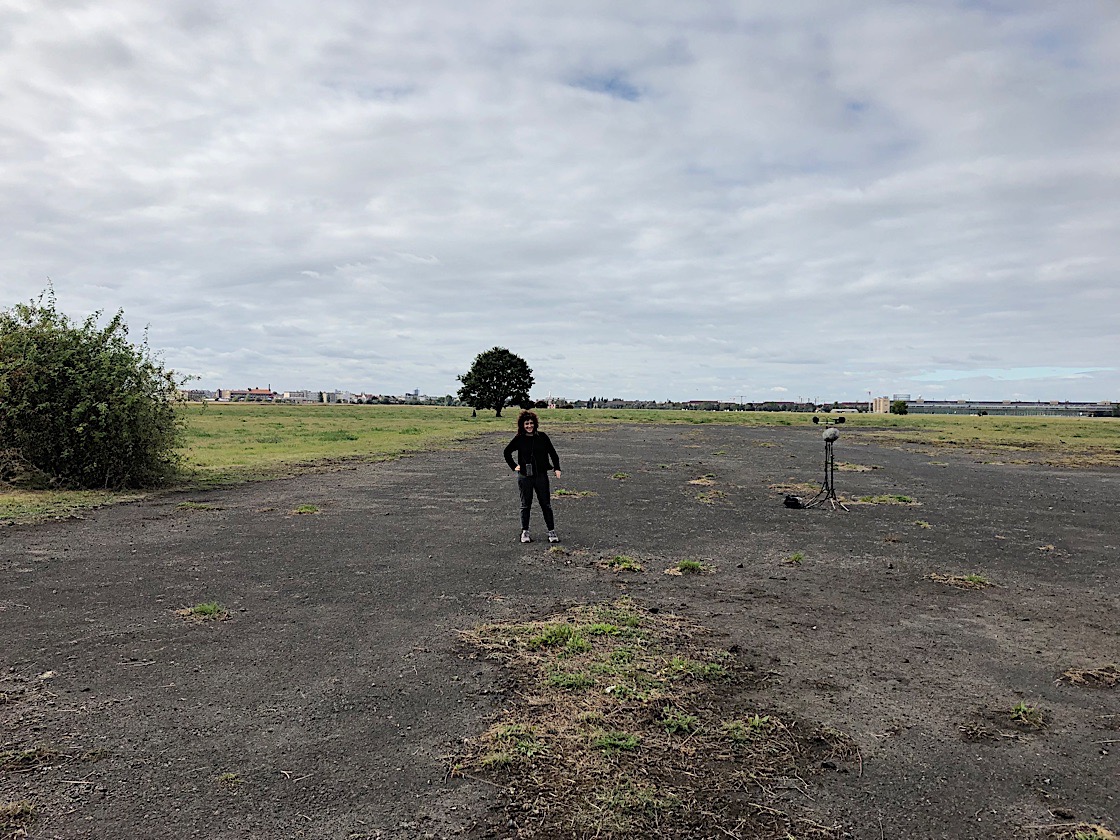
FIELD TEST 1
Tempelhofer Feld, Berlin | Fieldtest with SR-S4 long throw speaker
September 2019
Equipment: SR-S4L (long-throw) comprises speakers, each with eight 4" cone drivers and twenty-four 1" balanced dome tweeters, all aligned to form a continuous linear sound source. Weather resistant.
Other equipment: Power generator, amplifier, mp3 player, sound recordist.
I tested the TOA SR-S4L Long Throw model, which was generously supplied by TOA Europe to support my artistic research. A line array is a loudspeaker system that is made up of a number of usually identical loudspeaker elements mounted in a line and fed in phase, to create a near-line source of sound. The distance between adjacent drivers is close enough that they constructively interfere with each other to send sound waves farther than traditional horn-loaded loudspeakers, and with a more evenly distributed sound output pattern.
I chose to use cello samples to initially test the projection capacities of the SR-S4L. These samples comprised of different frequencies and timbres of a performed cello which would cover the majority of the frequencies I would use in performance. I chose the Tempelhofer Feld, the former airport which is now a park to test this speaker. I chose this environment as I knew there would be no physical obstacles to potentially interfere with the sound projection of the speaker.
There were two specific areas I was looking at for this speaker; firstly, how far it projected (and what) and what the spatial projection was like, for example did it disperse widely etc.
I found that the speaker threw the higher frequencies (440 Hz and up extremely well). In fact, so successfully that I could not find the end of the signal. What was interesting about this speaker was that it maintained the finer details of the sound it was projecting for a substantial distance. I would estimate this speaker threw a signal of around 660 Hz for over a kilometer across the flat terrain of the airport. (See map).
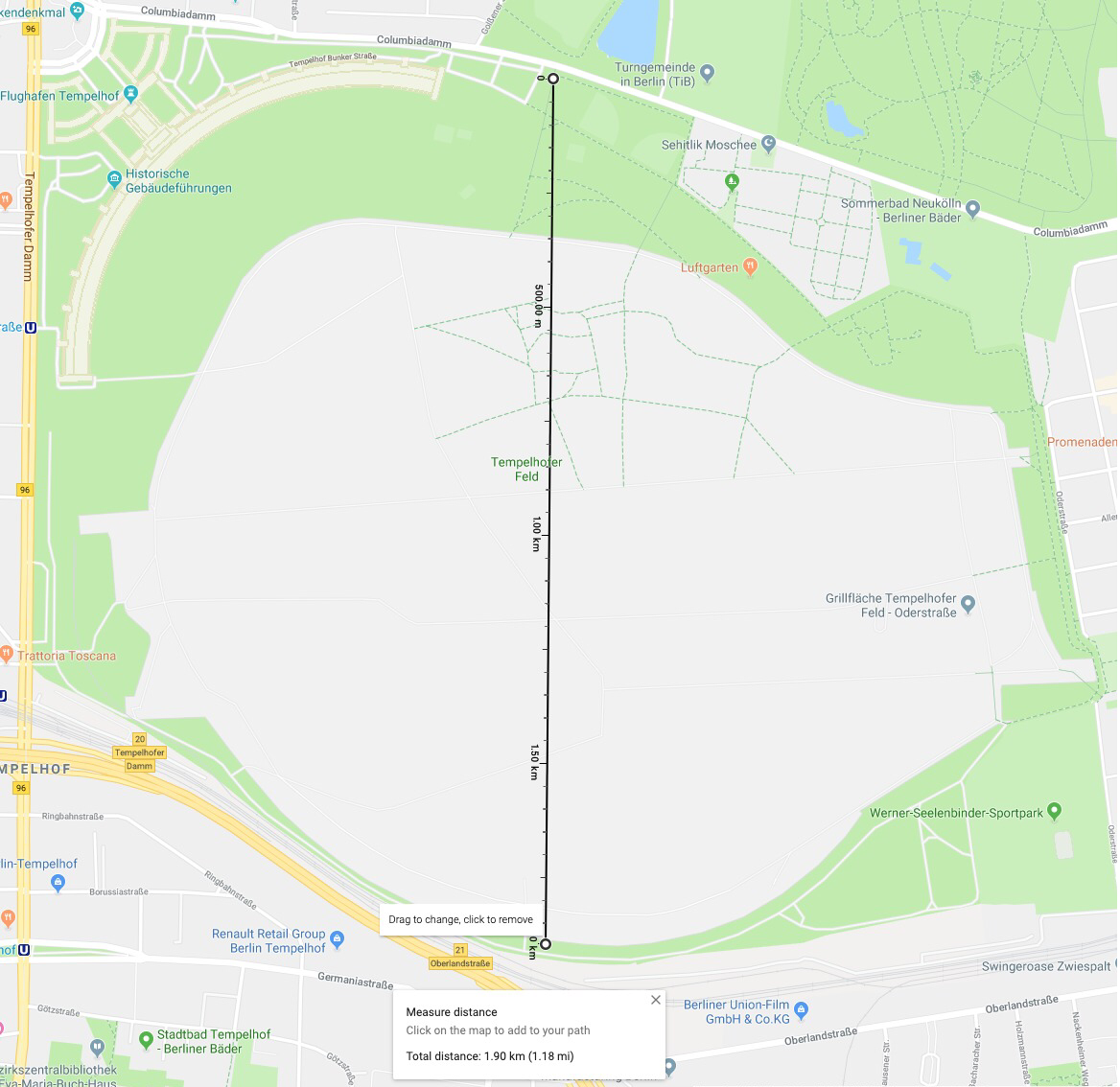
FIELD TEST 2
Zagreb, Croatia | Build and test parabolic speaker prototype 1
September 2019
After the testing of the TOA Speaker at the Tempelhofer Feld in Berlin, I decided that I still wanted to pursue a longer, more precise beam of sound, rather than the more wide radiation of the TOA long throw speaker.
Miodrag Gladović and I built a small parabolic prototype to test the research I had undertaken to confirm my theories on the sound projection and spatial phenomena it would produce.
This process alone was a clear indicator that my theories were correct. Parabolic technology is not newag . It is utilized in a variety of fields as a source of information collection. For example, the concrete sound mirrors in England, utilized in the Second World War for information retrieval.
And of course, the parabolic microphone used to focus on the collection or pinpointing sound sources from distances when recording.
We spent three days building and testing the basic function of the Parabolic prototype using a twenty-euro satellite dish as our parabola and attaching rudimentary arms to support a basic driver.
The most fascinating (and for me reaffirming research wise) part of the parabolic prototype build arose when we initially located the ‘sweet spot’ or the reflection center of the dish. Once we found the correct distance and center position of the reflection of the dish, it was clear that this type of technology was the exact technology I wanted to work with.
After calibrating the distance of the speaker with the parabola we were ready to test the prototype in the field. This consisted of two tests; outside on a flood plain in the outskirts of Zagreb and inside in a large club.
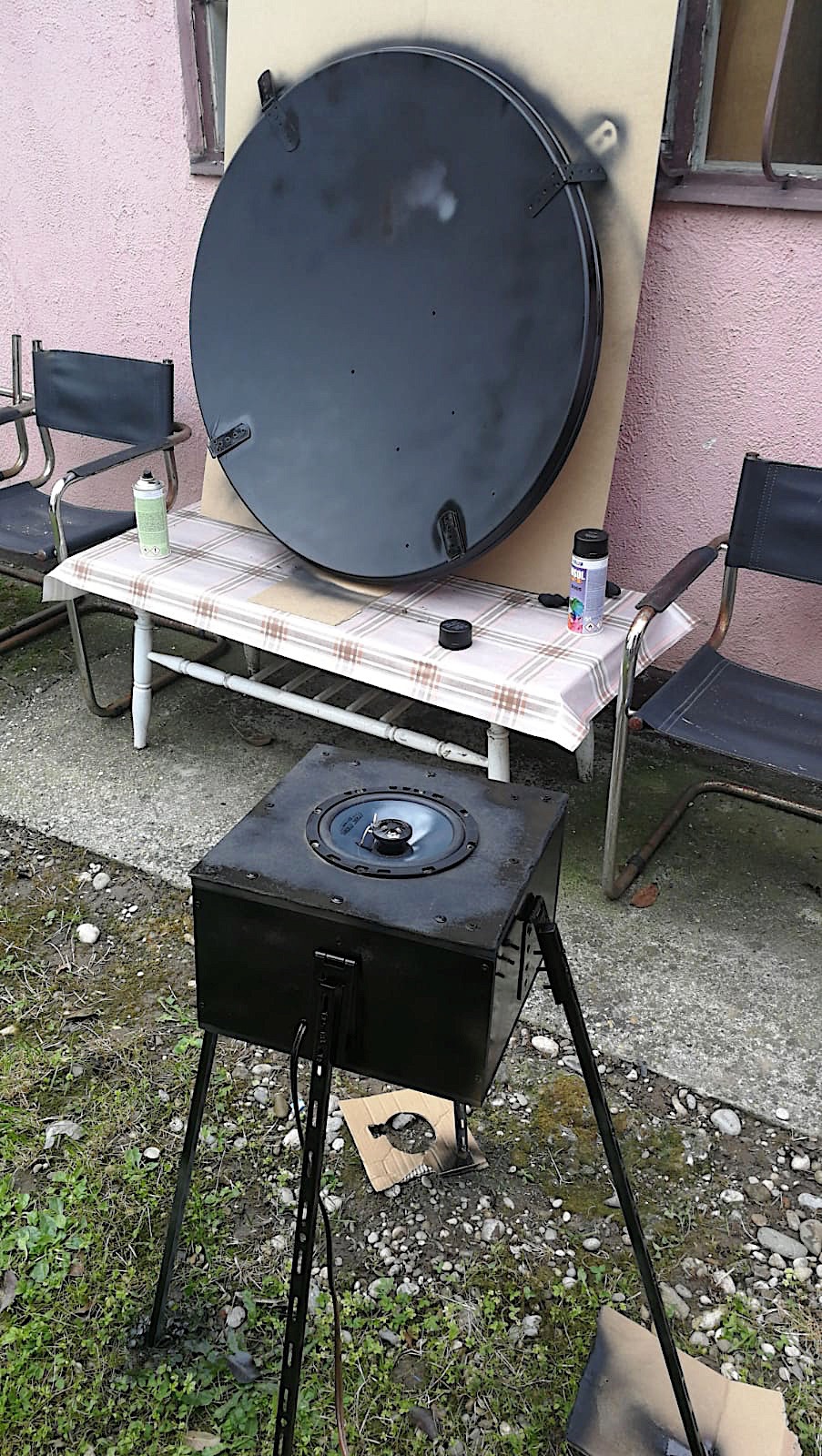
Močvara club, Zagreb | indoor test parabolic prototype 1
September 24th, 2019
This was the first field test of the Parabolic Prototype.
What we were looking for:
• A physically recognizable beam of sonic energy that one could walk in and out of.
• The width and length of the beam thrown from the parabol
• A powerful enough throw
• Physically recognizable reflections
• A reasonably good frequency spectrum of sound (being that it did not just throw the higher frequencies)
• ‘Secondary’ beam phenomena occurring from reflections in the room
What we found:
What we found was a clear and defined beam of sound of approximately 30 - 45 centimeters in width. This beam was extremely powerful, so standing too close within the energetic field being projected from the speaker (say the first 3 to 5 meters) was quite hazardous for our hearing. This powerful harnessing of energy through the parabolic shape indicated that the beam was powerful enough to throw sound for some distance. The effect of such a beam in the club space was very interesting; it creating multilayers of what I would describe as ‘room like’ or spatial phenomena. There was a significant amount of reflections in the main room and the room behind the main room where secondary partials and other phenomena occurred. Considering the size of the parabol the actual frequency tests were very successful, in stark contrast the hyper-directional technology I had tested.
We made a rudimentary test of the length of the throw and frequency response see photo of graph here:

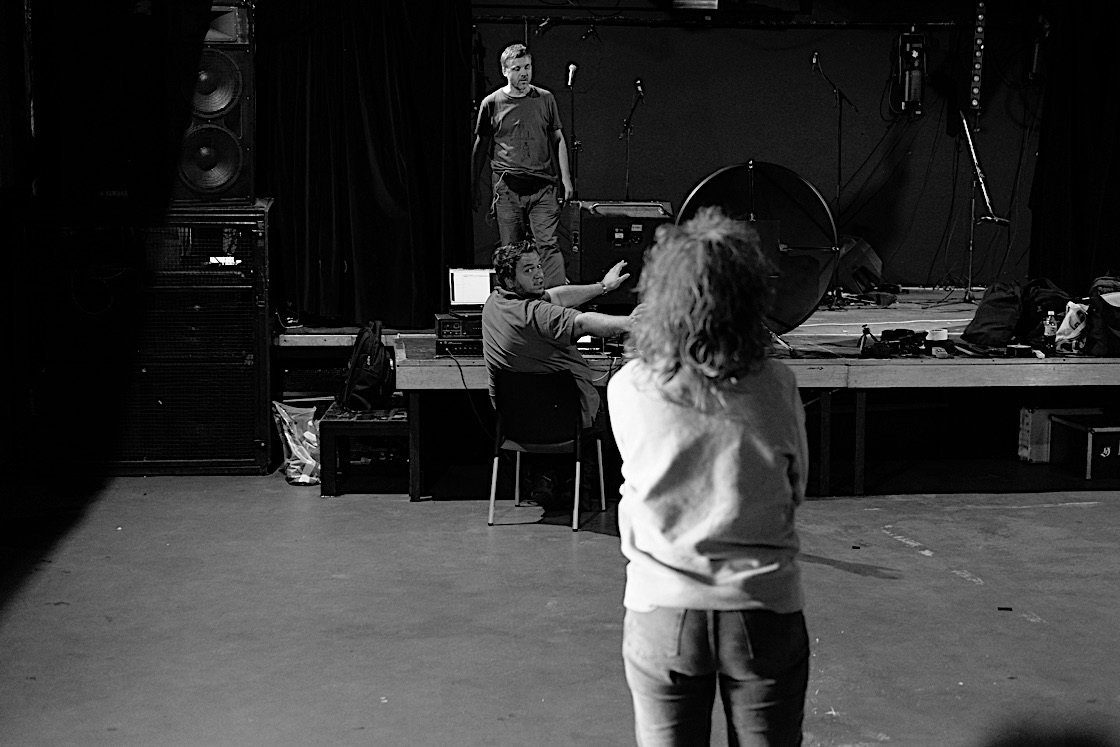
Flood plain - outskirts of Zagreb | outdoor test parabolic prototype 1
September 28th, 2019
What we were looking for:
• Length of throw (i.e. how far the sound throws before dissipating)
• Spatial width and length of beam outside of reflective room
• How the strength of the beam was affected by the outdoor environment
• The spatial throw; was it recognizable when walking in and out? Could we hear secondary sound outside of the throw and what was that?
• Spatial phenomena; what did we perceive?
What we found:
We set the speaker up in the back of Mijo’s car. This allowed for the correct height for the parabol beam to be at approximately head height. The reason we had chosen the environment was because it was flat and allowed for a straight beam throw without any physical disruption to the beam.
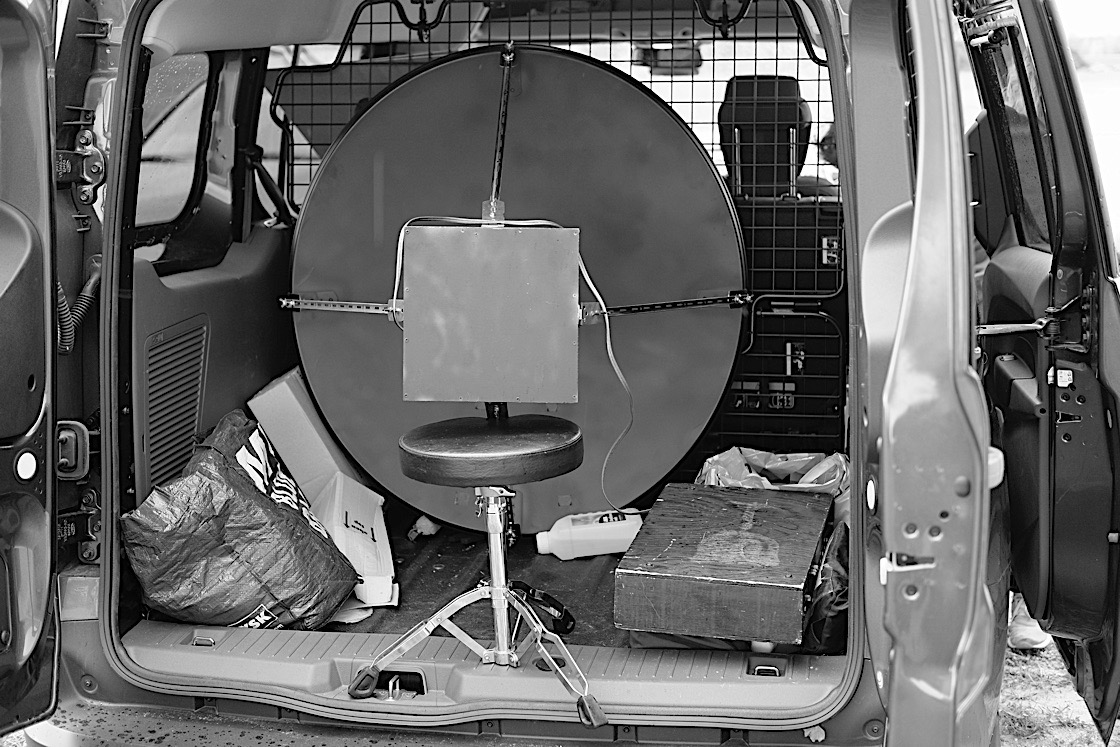
We sent sound through the speaker and began to walk away from the car. As in the club, the center or the beam was immediately perceivable when one was physically within it. When out of it, one would continue to perceive the secondary projection of the sound outside of the main beam.
We kept walking away from the speaker along the slope, waiting to hear when the beam would begin to weaken. Whilst we were doing this, the outside elements of the environment began to take audible effect. In particular the wind; when it would come up, the beam center would physically waver with the wind. This phenomena was extremely interesting and for me a major part of why I wanted to build these parabols in the first place; to find a way to incorporate multifaceted phenomena outside of my control. We continued to walk, and eventually we were so far away (maybe 600 meters?) that it began to rain. Having perceived the power of the throw, I could safely assume the length of the throw was at the very minimum 1.5 kilometers in length and the higher frequencies could carry for some kilometers if they were unimpeded by physical objects.
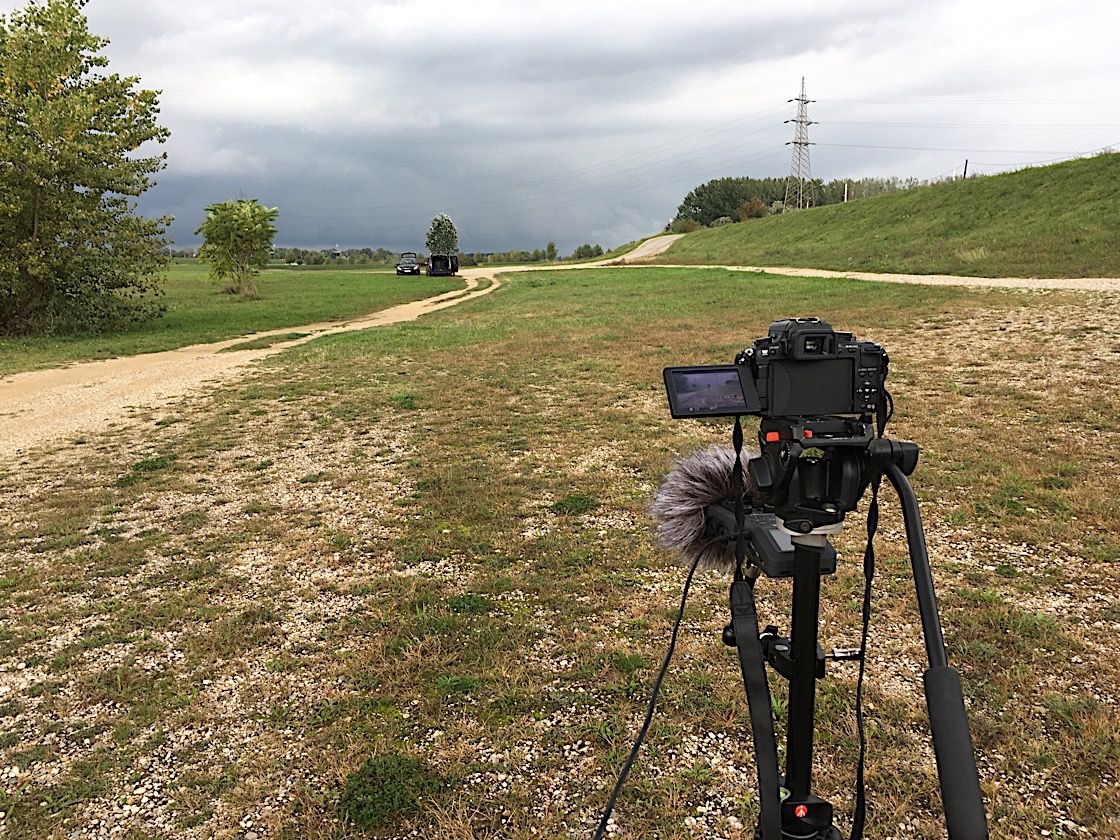
Findings:
The two tests we undertook for the parabolic prototype were extremely successful. We decided that we would build another parabol, moulded from fibreglass with a larger sized parabol as it would be the perfect media to articulate my exploration of energy transmission and projection.
FIELD TEST 3
De Maasvlakte, Rotterdam | outdoor test with SR-S4 long throw speaker
November 29th, 2019
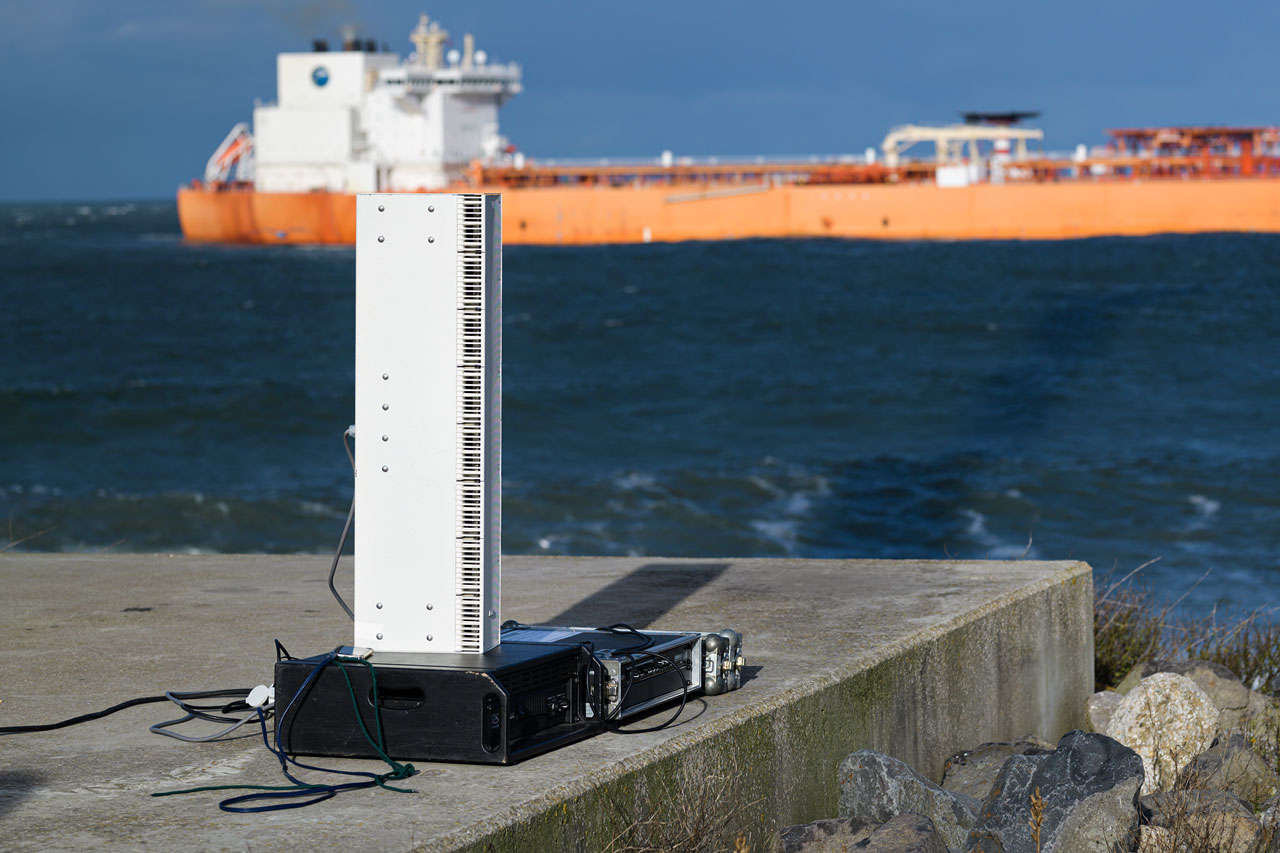
The TOA Long Throw Speaker was set up under a wind turbine in the harbour of De Maasvlakte powered by a generator. The exact location was chosen as it sits directly above the shoreline of the harbour. The speaker was positioned directly under a wind turbine chosen because of its raised flat concrete surface (on a hill sitting above other objects in the environment). This allowed relative ease in the selection of various positions for sound projection to the different elements of the environment; being water, beach and land including the various objects within them.
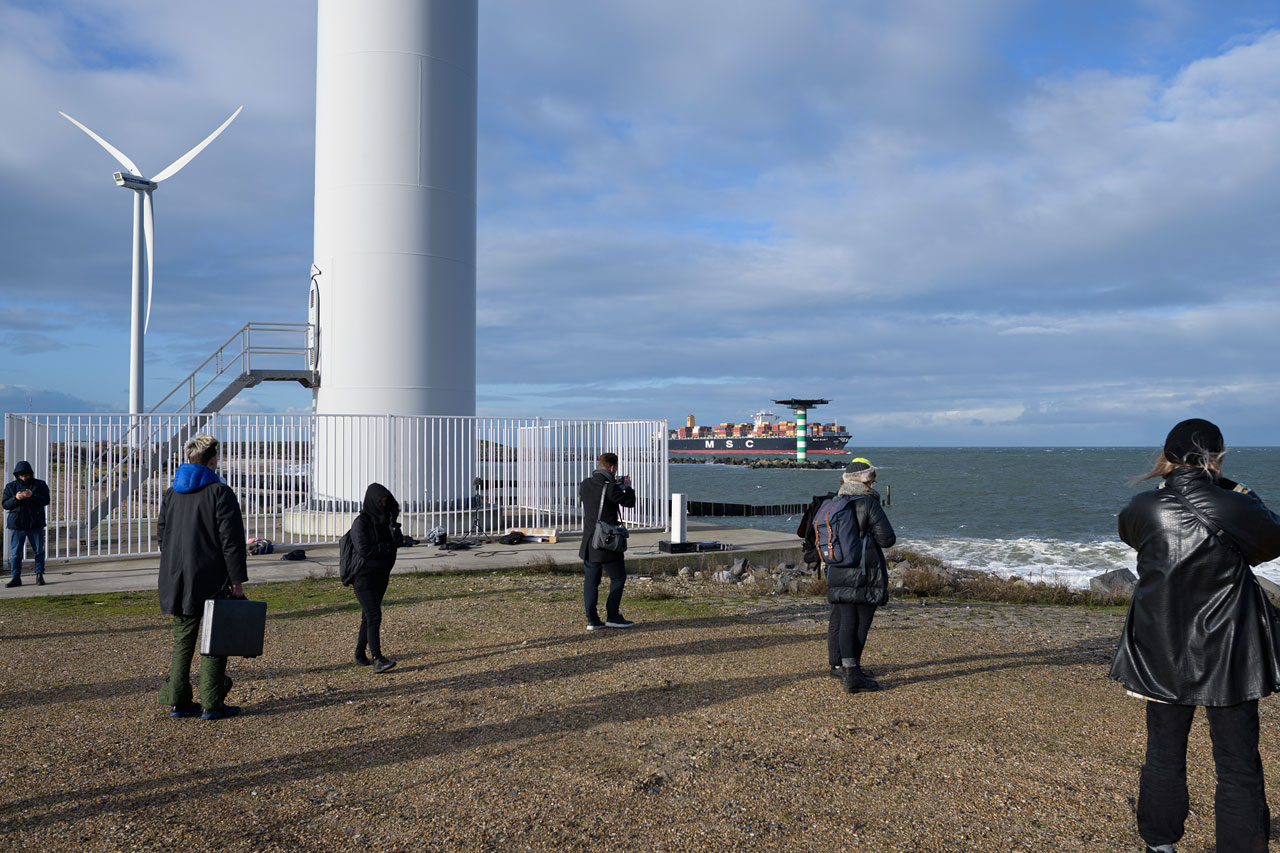
The atmospheric conditions of the day were of particular interest to this test, in particular, the large amount of wind. That day the wind came from a NNW-direction with a speed of 7,8m/s and wind gusts to a maximum of 15,0m/s. With this in mind, it became clear to me that this field test would predominantly involve experimenting with the natural and manmade environment and how this related to the atmospheric conditions.
What I was looking for:
• How wind interference or atmospheric changes in the environment effected or enhanced the signal
• Sound quality and length and width of radiation
• Reflection: phenomena created from surfaces of objects such as buildings, rocks, water
• Length of throw (propagation)
• Frequency spectrum over a larger scale
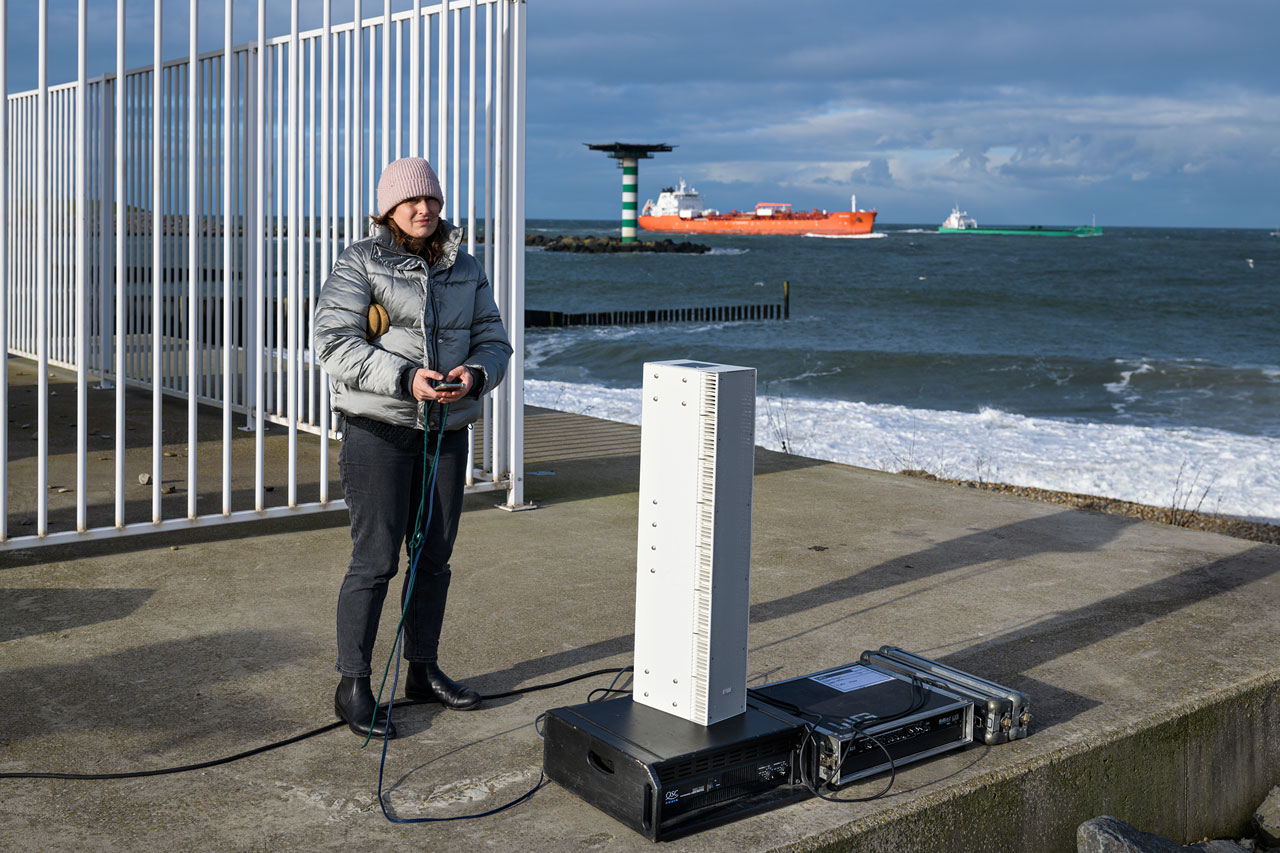
Findings:
There were two findings that came out of this test that warrant more field testing and theoretical research;
• The interaction of the wind with the sound projection; due to the sheer strength of the wind, the signal oscillation became irregular and (potentially) was carried by the wind (in its same direction) over what could have been quite a vast distance. I can assume that the wind carried the higher frequencies of the signal for some distance (over 5 kilometers at least).
• The reflection and interaction of sound energy from the TOA speaker with the objects in its immediate area. The phenomena that was produced was very distinct and extremely fascinating to me, particularly when it was being pointed at and reflected off the café wall approximately 20 meters away from the speaker.
In conclusion, I realized that the reflective behavior of the TOA and the subsequent phenomena it produced offered many artistic possibilities, particularly in large-scale outdoor environments where a wider depth of immersive sound is required.
FIELD TEST 4
Močvara club, Zagreb | | 2nd Prototype completion and testing
January 2020
2nd Prototype Build:
Throughout the months of October ‘19 to January ‘20 Mijo designed and build a parabola mold based on the successful findings from the first prototype. The parabola was cast in four parts from fiberglass that could be assembled (and dissembled) for more practical storage and transport.
The driver was then selected in relation to the size of the parabola. An encasement mold was also cast.
2nd Prototype Test | Club Močvara
Mijo then assembled the parabola and connected the driver in the club Močvara to finish the finer aspects of the build and for us to undertake the first test.
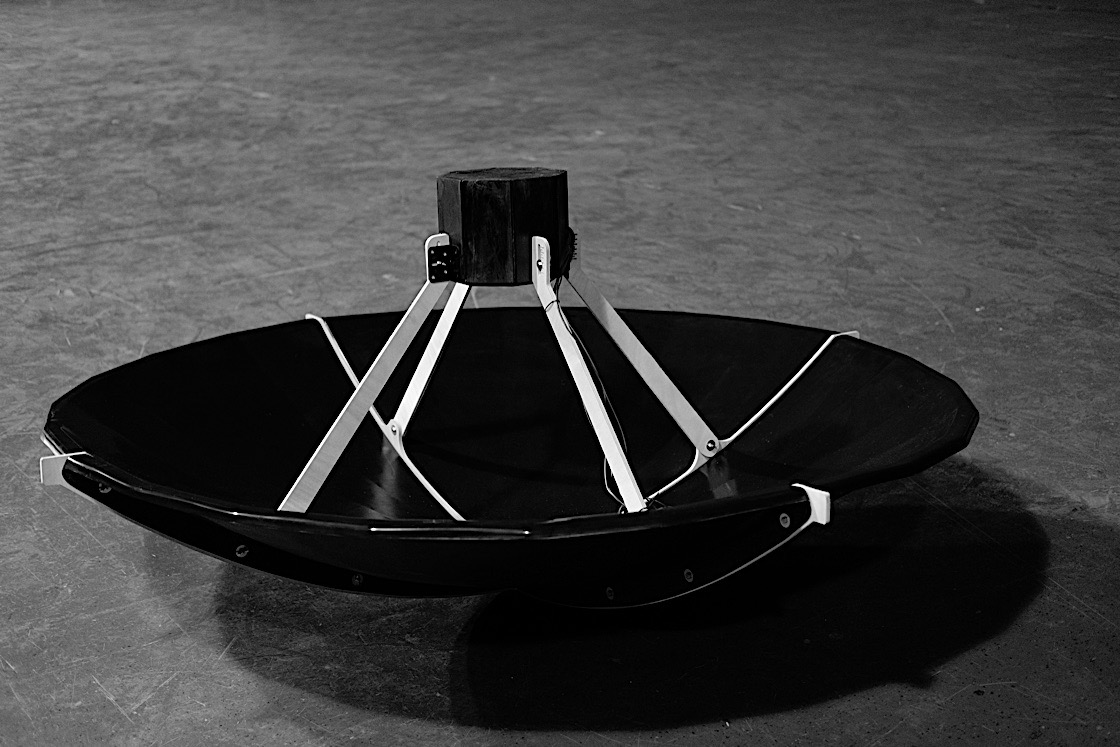
Once the parabola was assembled, we supported it by a number of chairs and began to check the precision of the beam. The beam was stronger and wider than the smaller prototype (obviously) and there was again a recognizable beam of sound energy.
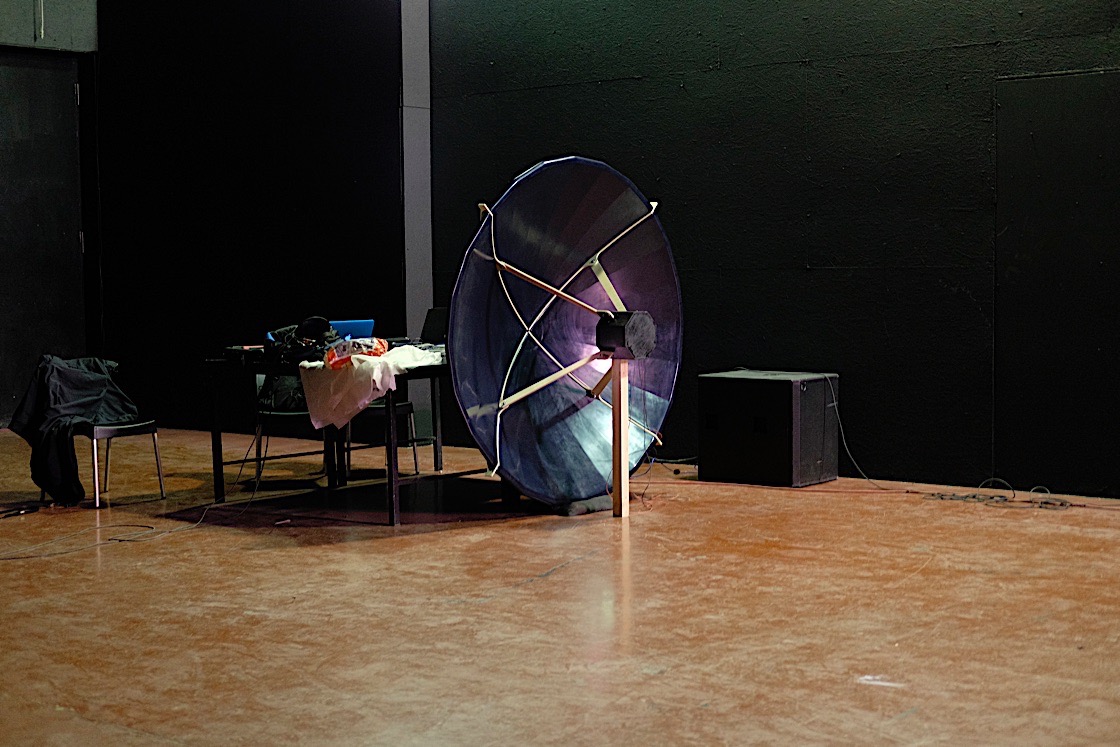
When this beam of sound was projected from one end of the space to the other a significant amount of sonic and spatial phenomena was produced. What exactly was physically produced requires further theoretical research.
Measurements of Club Močvara:
area: 401,8 m2
width: 11,89 m
length: 33,80 m
height: 7,93 m
Similar to the first prototype we experienced a number of varying phenomena within this large space. We auditioned various sound; music, high frequency/ low frequency and then began to test live cello. Notable we had not tested any live cello in the last tests.
2nd prototype and live instrumental performance | violoncello
We knew that the premier of these speakers would be part of the Sonic Acts Academy in February 2020 at the Stedelijk Museum in Amsterdam. It would be held inside, in their large foyer with live performed cello. As this would be our only opportunity to test the initial function of the 2nd prototype and how it interacted with live (acoustic) and amplification before installing in the Stedelijk Museum we decided to test this.
It is important to make an artistic caveat here; I initially wanted to install the speaker outside of the Stedelijk Museum, in the front in the large square. However, due to increasing issues with sound, something like this would require serious amounts of paperwork and approvals in Amsterdam.
What we were looking for:
• Frequency response with various performed frequencies of the cello
• Feedback issues with microphones and transducers
• Proximity to speaker of performer: how close/far could we be? This would be important for planning a physical sound plot for the Stedelijk Museum
• Spatial and sonic phenomena of throw when speaker performed live
• Mono? Do we need further bass frequency information ie subwoofer? Would the standalone parabola be enough in a large space acoustically and frequency wise?
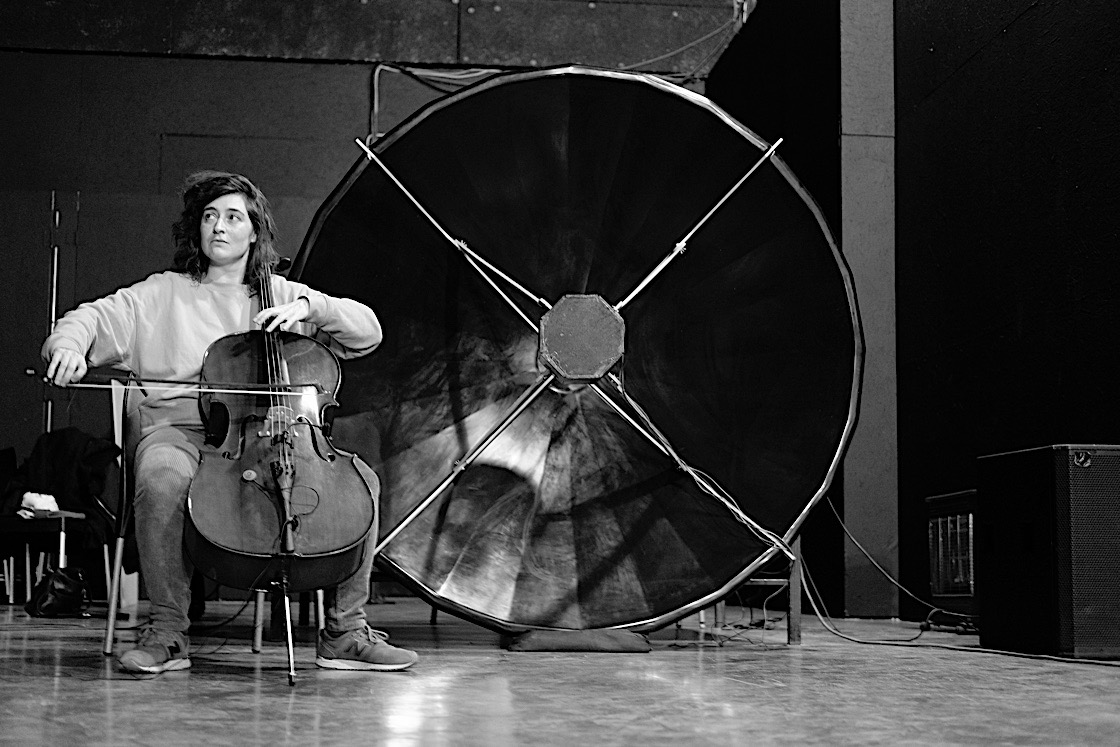
What we found out:
The speaker could be used standalone without any other speakers. We tested a subwoofer alongside the speaker with live performance and found that it detracted from the spatial phenomena produced by the parabola speaker. I found this extremely interesting, and when one understands the basic radiation of low frequency information such as from a subwoofer, hardly surprising it might mask the higher frequencies. However, in saying that, if one were in an even larger space, or indeed outside, there could be a possibility to tune both parabola and a specific subwoofer to effectively not combine their signals. However, in this size space, the sub information masked or detracted the higher beam phenomena.
We found that the cello as an acoustic device requiring a microphone would need to be behind or some distance away to gain the level of signal desired from the microphones. This is a problem that I would like to flag for performances in general and sound plotting. This speaker is not for proscenium performance, in fact quite the opposite.
We found that the frequency response of the speakers was surprisingly good. Much better than the TOA counterpart, which I would argue is of a completely different design and use. Mijo decided we should build a second parabola, based exactly on the first, to take to the Stedelijk in February as we would need more sound information.
TEST 5
Stedelijk Museum, Amsterdam | Test and performance with 2 parabolic speakers
19th - 21st February 2020
By the time of the live concert in Amsterdam, Mijo and I produced a second parabola speaker. Two parabolic speakers had been carefully packed, as per their design into a 1 x 1 m road case and shipped to Amsterdam from Zagreb.
Mijo along with an assistant built up the speakers within an hour. They now have two metal supports that fit into a generic PA speaker stand and are very modular in their set up.
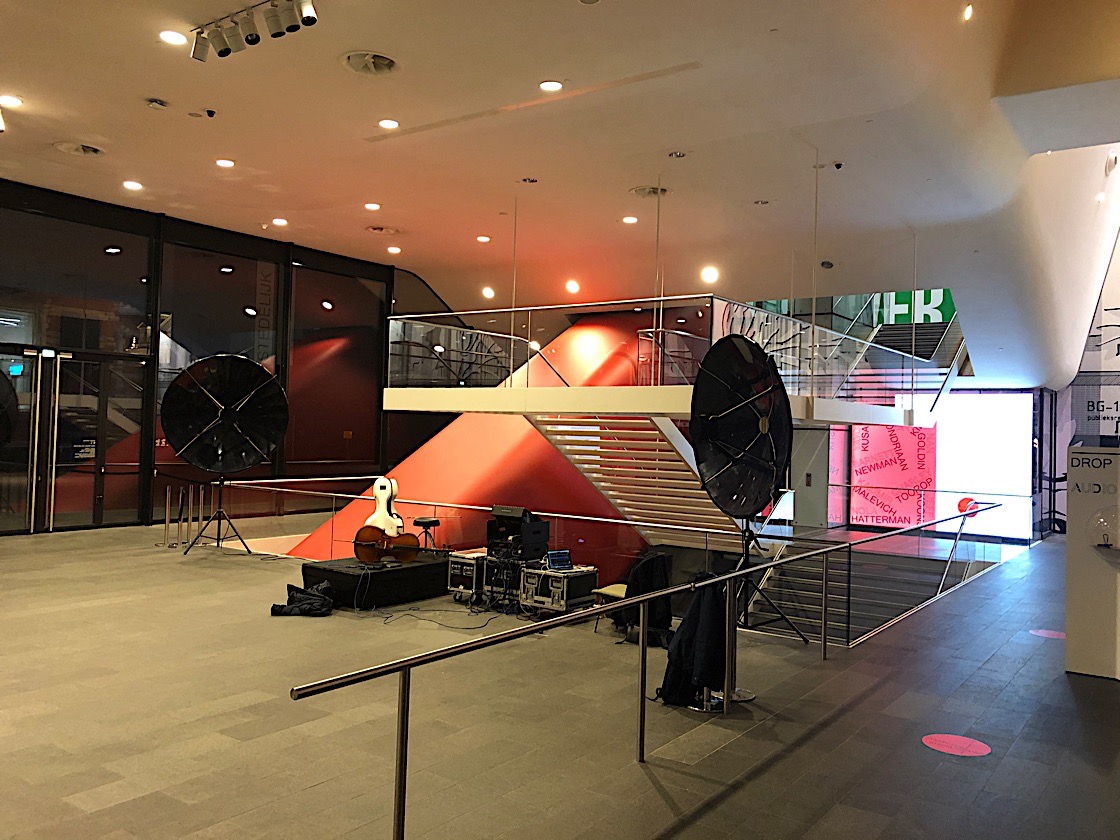
Live testing in the Stedelijk Schiphol Lounge
Once the speakers were set up we began basic testing. This entailed:
• Position of speakers
• Position of cello/performer
• Set up of cabling, mixer etc.
• Initial testing and tuning of space
Once the speakers were set up and the sound was working, we began to explore the possibilities of sound projection and the subsequent phenomena it would produce within the space. The speaker projection worked so well; the options became quite limitless. The main foyer possesses large floor to ceiling glass windows on one side, and on the other, large doors and brick walls. The potential for multiple reflections was evident in this space.
In the end, we found the louder sound on the speakers was less interesting then that quieter, however, were aware of the effect of many people on the space, and how that would quickly dampen and affect the sound. We were also aware that the audience may well not be so well aware of what a spatial performance entails. As there were two performances programmed, we decided to stick to a quieter first performance which really made use of the possibilities of the speakers and a second more performative that might be more public friendly in such a context.
Live performance Anthea Caddy | 21st February 2020
The live performance was exactly how we had thought it would be. The first quieter more spatial and phenomena producing set got lost in the movement of people. It became clear that in performance, there needs to be (at least for this audience) a more performative set. Which, of course, became the second.
As a performer, I have a lot to say here in relation to these speakers, however for the purpose of this report I shall keep it in dot point.
Outcomes from the speaker performance
• No proscenium set up. Cello should never be in between speakers for audience, it ruins the listening experience and deters people from the main event being the projection of the speakers
• Any further inside performance should be undertaken as either an installation (meaning sound files and no performer) or the performer must be in another room, away from the audience all together
• Inside performances are of interest, however, these speakers were designed for outside projection, to expand and highlight larger fields of listening, inside performances should be considered as installations that can focus on modes in rooms and speaker projection alone. This does not discount inside performance, as these speakers were designed to interrogate phenomena within all spaces, however it must be done in an installed or very focused performance context
• Do we want more speakers? A question not yet answered!
• This performance made me realize how excellent these speakers could be installed outside, and across water, through forests etc. In particular reflecting off large objects in environments
• Do we connect a mechanical rotating device to rotate the speaker and therefore the beam?
• How can we manage difficult sound conditions such as city sound requiring permits etc.?
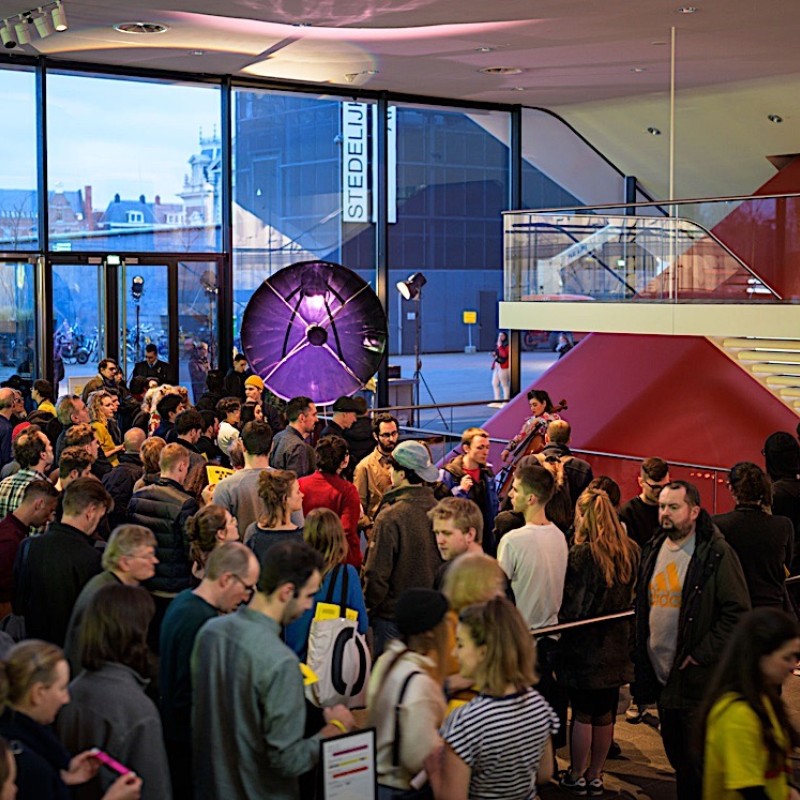

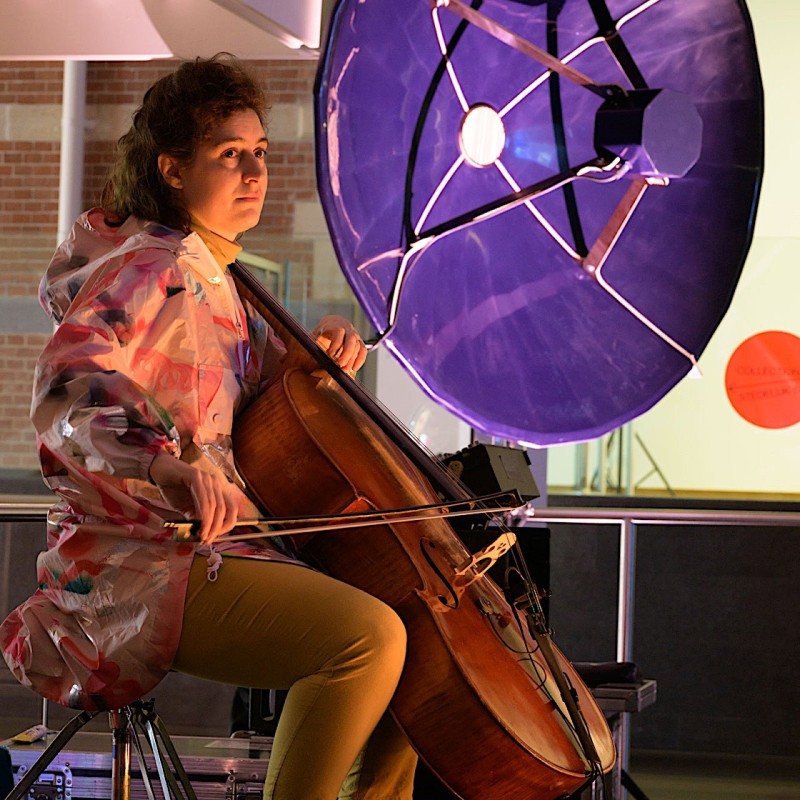
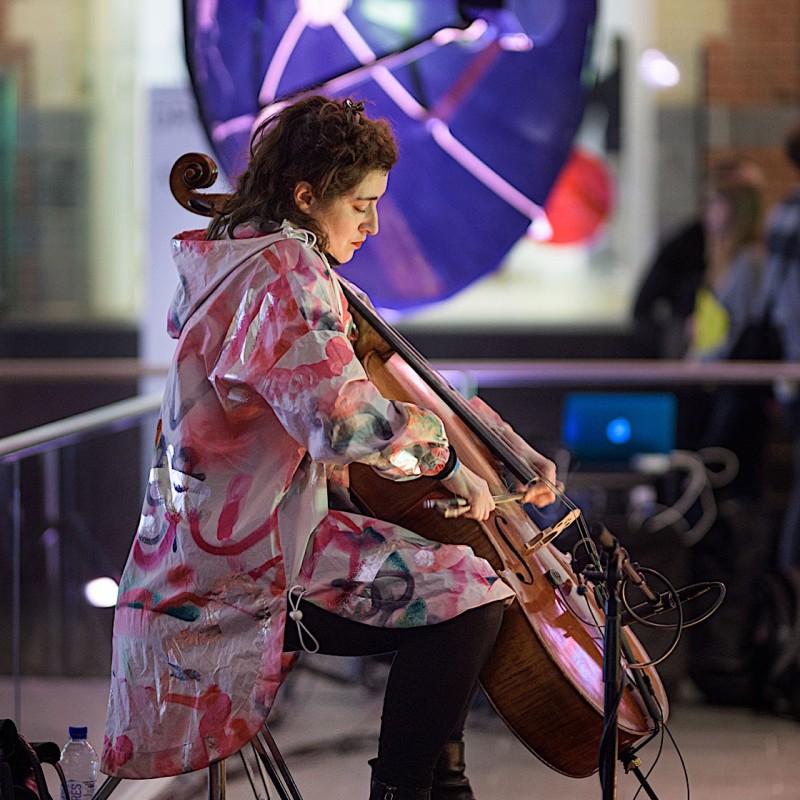
TEST 6
Nikolai Tesla Museum, Zagreb | Test and performance with 2 parabolic speakers
September 22nd 2020
The two completed parabolic speakers returned to Zagreb to be set up in the large car park of the Nikolai Tesla Museum, Zagreb.
We had limited time to set up. However, it was evident from our previous tests that this environment would be ideal for creating an expanded (and potentially complicated) spatial projection of the expanse of the car park. Furthermore, it was evident that the physical objects surrounding the car park, being the large museum building wall and the concrete boundaries surrounding the museum would be ideal for projection; beam length and beam reflection.
What we wanted to achieve:
• An (large) expanded ‘field’ or environment of reflected spatial energy
• The speakers could highlight the space and then redirect the audience to the spatial phenomena occurring (rather than the performer)
• A non-proscenium performance
• Visibility of speakers and not performer
• Audience mobility around the works
• Audience awareness of the physical environment surrounding the work, meaning the environment became equal part of the artwork
What we achieved:
The space for us was perfect. We decided on two physical set ups for the speakers; one being alongside a fence projecting back onto the museum building walls, and one projecting from the museum walls and reflecting off the fence
The second performance would comprise the two speakers set up parallel to each other; one on one side of the carpark and one on the other. The beams would shoot straight across and not reflect their beams off any objects.
The audience could move freely around the carpark able to experience the spatial phenomena highlighted by the speaker beams of the environment.
The cello would be housed out of site in a small shed so as not to disrupt or detract from the spatial phenomena produced from the speakers.
We began to assemble the speakers, set up and test the output and plug in the cello. Unfortunately, it began to rain very heavily and we were deterred by the elements. After bringing the speakers in and disconnecting all the audio, the rain stopped and we returned to our set up. Unfortunately, by this time, we had very little time to set up before the audience was expected to arrive, so work became rushed. After reconnecting the first speaker we undertook a test of the cello signal. The speakers sounded excellent. But, we blew a driver.
This meant that we were unable to set up the way we originally planned as we now had only one speaker working and thus, half the amount of sound information. We decided to keep one speaker where it was and perform the single projection. Of course, the result was still very good. It articulated the spatial phenomena successfully, however, we did not have our full set up, and were not prepared for only mono speaker performance (which I think can be done very well under the right context and conditions).
The outcomes of this test were:
• A decision to upgrade the speaker drivers including having a spare in case of another blowout
• A decision to always ask for more set up and testing time in case of an interruption or other external factors
• Outside performance in large open areas is at the moment my preference, and I find extremely successful in regard to my original artistic concepts
• With new more powerful drivers for projection we can be more ambitious with larger spaces for example; islands, light houses, mountains
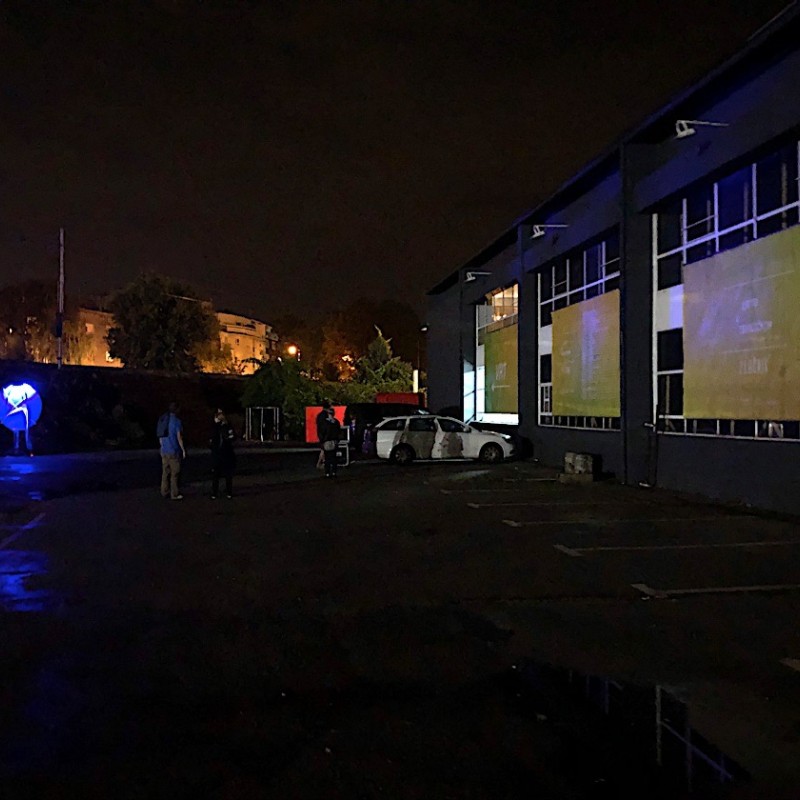
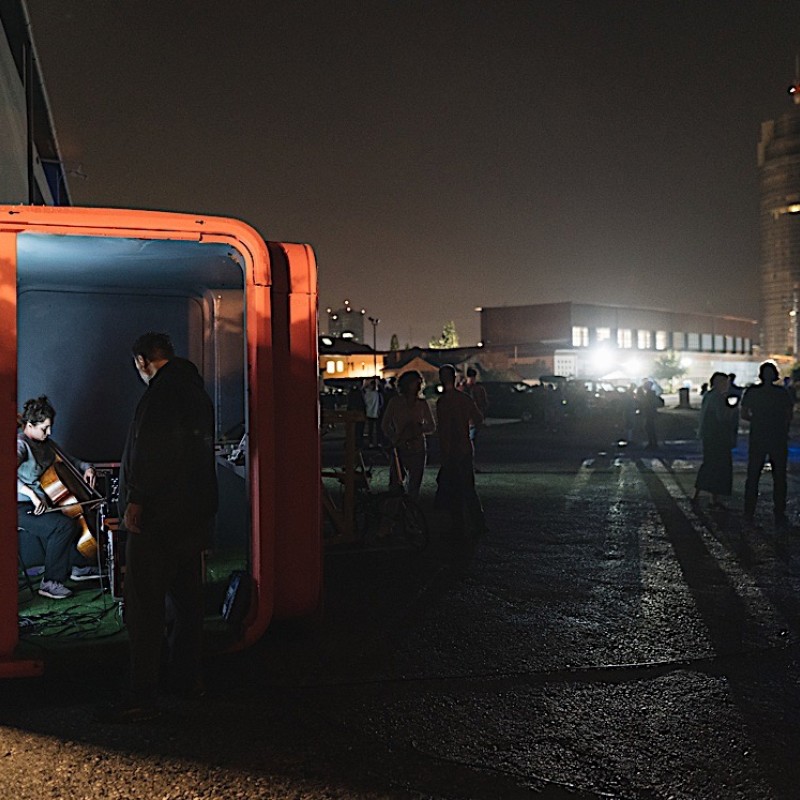
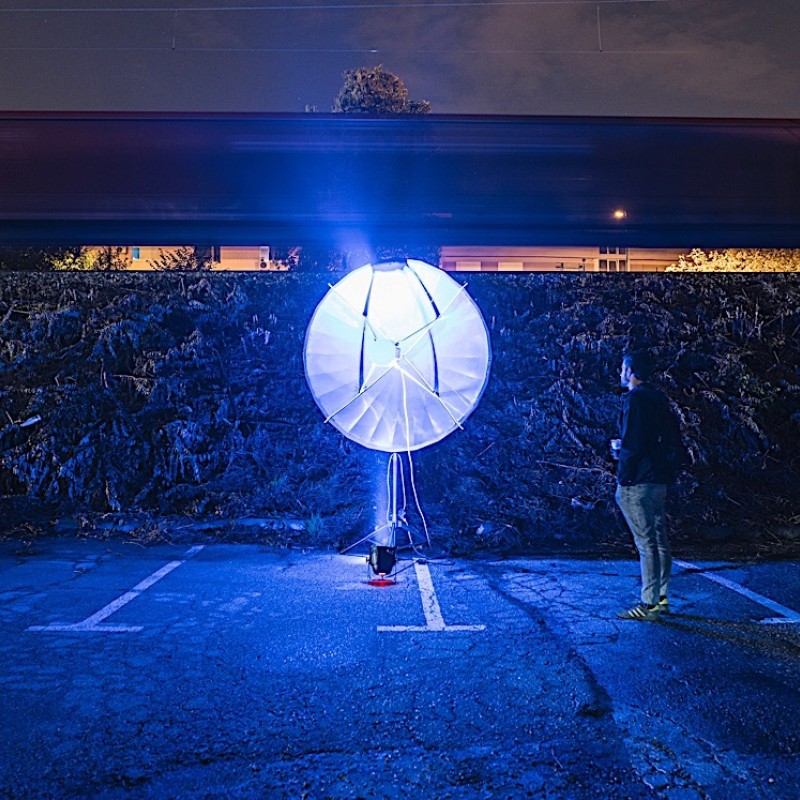
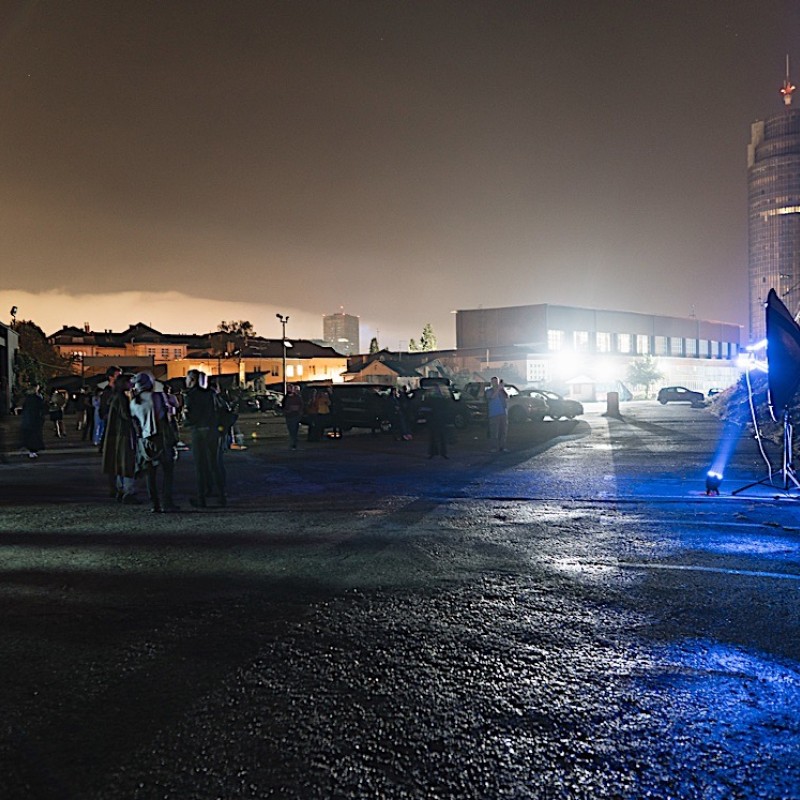
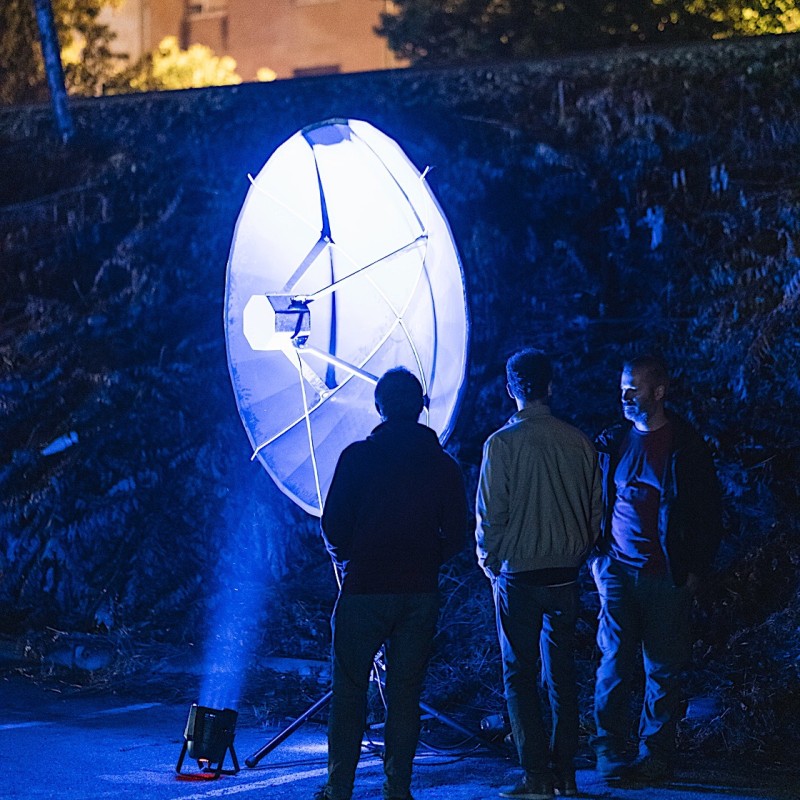
Credits:
Hardware development in collaboration with Miodrag Gladović.
Supported by: Australian Council for the Arts, National Institute of Experimental Arts, UNSW, Australia, Sound, Energies and Environments Research Group, UNSW, Australië.
Additional support: AVC Zagreb, TOA Europe, Club Močvara.
Presentation partners: Sonic Acts, Kontejner Zagreb.
Thanks to Douglas Kahn.
Links:
https://antheacaddy.net
https://2020.sonicacts.com/artists/anthea-caddy
https://www.kontejner.org/projekti/touch-me/-7-doticemo-nove-buducnosti/re-imagine-europe-2/
http://www.upogoni.org/korisnik/resursi/jedinstvo-velika/
